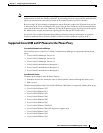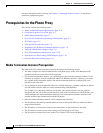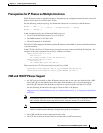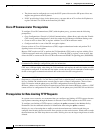
17-6
Cisco ASA Series Firewall ASDM Configuration Guide
Chapter 17 Configuring the Cisco Phone Proxy
Prerequisites for the Phone Proxy
For more information about licensing, see Chapter 5, “Managing Feature Licenses.” in the general
operations configuration guide.
Prerequisites for the Phone Proxy
This section contains the following topics:
• Media Termination Instance Prerequisites, page 17-6
• Certificates from the Cisco UCM, page 17-7
• DNS Lookup Prerequisites, page 17-7
• Cisco Unified Communications Manager Prerequisites, page 17-7
• ACL Rules, page 17-7
• NAT and PAT Prerequisites, page 17-8
• Prerequisites for IP Phones on Multiple Interfaces, page 17-9
• 7960 and 7940 IP Phones Support, page 17-9
• Cisco IP Communicator Prerequisites, page 17-10
• Prerequisites for Rate Limiting TFTP Requests, page 17-10
• End-User Phone Provisioning, page 17-11
Media Termination Instance Prerequisites
The ASA must have a media termination instance that meets the following criteria:
• You must configure one media termination for each phone proxy on the ASA. Multiple media
termination instances on the ASA are not supported.
• For the media termination instance, you can configure a global media-termination address for all
interfaces or configure a media-termination address for different interfaces. However, you cannot
use a global media-termination address and media-termination addresses configured for each
interface at the same time.
• If you configure a media termination address for multiple interfaces, you must configure an address
on each interface that the ASA uses when communicating with IP phones.
For example, if you had three interfaces on the ASA (one internal interface and two external
interfaces) and only one of the external interfaces were used to communicate with IP phones, you
would configure two media termination addresses: one on the internal interface and one on the
external interface that communicated with the IP phones.
• Only one media-termination address can be configured per interface.
• The IP addresses are publicly routable addresses that are unused IP addresses within the address
range on that interface.
• The IP address on an interface cannot be the same address as that interface on the ASA.
• The IP addresses cannot overlap with existing static NAT pools or NAT rules.
• The IP addresses cannot be the same as the Cisco UCM or TFTP server IP address.


















